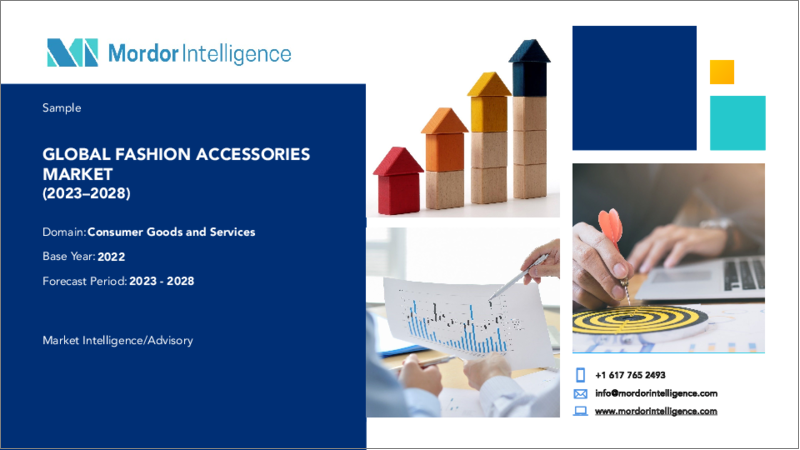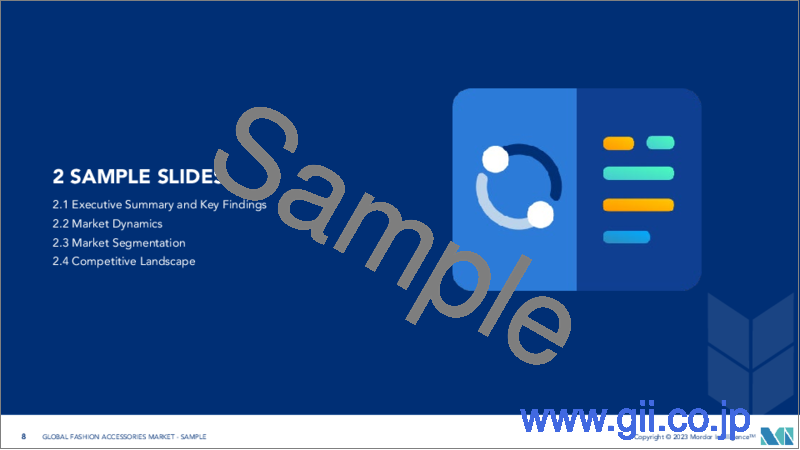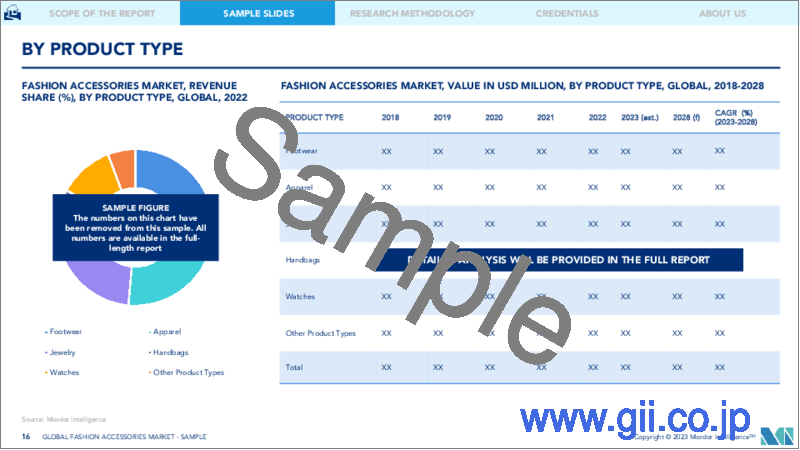|
|
市場調査レポート
商品コード
1190824
ファッションアクセサリー市場- 成長、動向、予測(2023年~2028年)Fashion Accessories Market - Growth, Trends, and Forecasts (2023 - 2028) |
||||||
|
● お客様のご希望に応じて、既存データの加工や未掲載情報(例:国別セグメント)の追加などの対応が可能です。 詳細はお問い合わせください。 |
|||||||
| ファッションアクセサリー市場- 成長、動向、予測(2023年~2028年) |
|
出版日: 2023年01月18日
発行: Mordor Intelligence
ページ情報: 英文 156 Pages
納期: 2~3営業日
|
- 全表示
- 概要
- 目次
ファッションアクセサリーの世界市場は、次の予測期間中に12.3%のCAGRで推移すると予測されています。
ファッション業界は競争が激しく、特に製品のデザインや改良において継続的な革新と開発が必要であり、消費者動向の変化がファッションアクセサリー市場の成長を促進しています。消費者行動の変化、購買力の向上、都市人口の増加などにより、インドなどの新興国からの市場貢献が高まっています。United Kingdom Economic Accounts Time Series Datasheet」によると、英国の衣料品および履物に対する家計最終消費支出は、本年中に16.2%の伸びを記録しています。また、インターネット、ソーシャルメディア、eコマースの普及により、Tier2以下の都市の消費者がトップブランドの製品にアクセスできるようになりました。
世界的にブランド志向の強い消費者が増えていることから、主要プレイヤーは、世界のさまざまなセグメントで新製品を投入し、消費者の注目を集める戦略を採っています。さらに、フィットネス動向やファッションに対する意識の高まり、有名人の推薦、公共サービス指令、オンラインマーケティング戦略、企業のインセンティブなども、最新のファッション動向を追いかけ、フィットネスを維持したいという衝動に影響を与えており、こうした要因が、様々な小売チャネルを通じた流行のファッションやスポーツアクセサリーの購入を促進していますが、中でもeコマースが最も好ましい購入メディアになっています。
主な市場動向
ファッションアクセサリー市場を牽引するプレミアム化
顧客、特にミレニアル世代とジェネレーションZは、高い可処分所得と世界のファッション動向への露出の増加を伴うファッション感覚の進化により、高級ファッション衣類にますますオープンになっており、様々なブランドの高級ファッションアクセサリーを試したいと考えているようです。また、労働統計局によると、米国では現在、35歳から54歳の顧客が衣料品に最も高い支出力を持っています。社会化が進み、さまざまな小売チャネルでブランドアクセサリーに触れる機会が増えていることが、消費者の購買意思決定に影響を与え、高級ファッションアクセサリーにもっとお金を使いたいという誘惑に駆られているのです。
さらに、新興経済諸国における都市化とデジタル化の影響により、顧客のライフスタイルは過去10年間で大幅に変化しました。中産階級の人々は、ファッションウェアやパーソナルグルーミング製品への支出に前向きになっており、これがアジア太平洋や中東などの主要地域における市場成長の原動力になると予想されます。さらに、これらのプレミアムブランドは、インドやサウジアラビアなどの地域で高まっているモードファッションの需要を取り込み、精神的・様式的な要求に応えようとする消費者の間で人気を博しています。世界的に見ると、モードファッション産業は2,770億米ドルの規模に達し(State of the Global Islamic Economy Report 2020/21)、サウジアラビアが主要市場の1つを占めています。最近では、2022年にGucciがサウジアラビアを含む中東の控えめなニーズに合わせてデザインされたプレミアムモダンコレクション「Nojum」を発表しています。
アジア太平洋地域が最も急速に成長している市場
ラグジュアリーなライフスタイルへの魅力の高まり、高い購買力、セレブリティの支持の影響力が、この地域の市場成長を牽引しています。アジア全域で急速な経済拡大が起こっており、インドや中国などの国々がその中心的な役割を担っています。その結果、インドと中国は、欧米以外のファッションアクセサリーの市場として魅力的になってきています。オフラインの店舗を中心に勢いをつけるため、この地域の小売業者はテクノロジーを活用し、デジタルマーケティングのディスプレイやチェックアウトで店内体験を向上させています。力強い経済成長と技術的な節約志向の高まりにより、この地域は予測期間中、ファッションアクセサリーの次の大きなチャンスになると思われます。
さらに、消費者は以前よりもずっと健康に気を配るようになり、人生を変えるような行動を取るようになりました。日本では、2021年11月にスポーツ庁と共同で実施した調査により、20代の回答者の15.1%がフィットネスクラブを利用していると回答しています。同様にオーストラリアでは、25~35歳の45.80%がジムやフィットネスクラブ、レジャーセンターなどに通う習慣があると回答しています。このように、アジア太平洋地域のスポーツアパレル需要の増加に伴い、ファッションアクセサリー市場も拡大しています。
競合情勢
この市場は競争が激しく、主要な市場シェアを争う主要企業と、市場シェアを獲得するために小規模な地域に対応するプレーヤーが存在します。Kering Group, LVMH Moet Hennessy Louis Vuitton, Hermes International S.A., Inditex, Industria de Diseno Textil S.A., H &M Groupがこの市場の主要企業です。これらのプレイヤーは現在、製品のオンラインマーケティングとブランディングのために、ソーシャルメディアプラットフォームとオンライン流通チャネルに焦点を当て、顧客の関心を最大限に引きつけています。主要プレイヤーは、市場の技術革新がもたらす機会を活用し、ユニークで魅力的な高品質の製品を提供することで、様々な製品セグメントの要件に対応する製品ポートフォリオを拡大し、購入の利便性を向上させることに重点を置いています。
その他の特典
- エクセル形式の市場予測(ME)シート
- アナリストによる3ヶ月間のサポート
目次
第1章 イントロダクション
- 調査の前提条件と市場の定義
- 調査対象範囲
第2章 調査手法
第3章 エグゼクティブサマリー
第4章 市場力学
- 市場促進要因
- 市場抑制要因
- ポーターのファイブフォース分析
- 供給企業の交渉力
- 買い手/消費者の交渉力
- 新規参入業者の脅威
- 代替品の脅威
- 競争企業間の敵対関係
第5章 市場セグメンテーション
- 製品タイプ
- フットウェア
- アパレル
- 財布
- ハンドバッグ
- 時計
- その他の製品
- エンドユーザー
- 男性
- 女性
- キッズ/チルドレン
- ユニセックス
- 流通経路
- オフラインチャンネル
- オンライン
- 地域
- 北米
- 米国
- カナダ
- メキシコ
- その他北米地域
- 欧州
- スペイン
- 英国
- ドイツ
- フランス
- イタリア
- ロシア
- その他の欧州地域
- アジア太平洋地域
- 中国
- 日本
- インド
- オーストラリア
- その他アジア太平洋地域
- 南米
- ブラジル
- アルゼンチン
- その他の南米地域
- 中東・アフリカ地域
- サウジアラビア
- 南アフリカ共和国
- その他中東・アフリカ地域
- 北米
第6章 競合情勢
- 最も採用されている戦略
- 市場シェア分析
- 企業プロファイル
- Giorgio Armani S.p.A.
- LVMH Moet Hennessy Louis Vuitton
- Dolce & Gabbana
- Kering Group
- Tapestry Inc.
- Fossil Group Inc.
- Inditex, Industria de Diseno Textil S.A
- Prada SpA
- Chanel SA
- Luxottica Group SpA
- Tommy Hilfiger
- House of Titan
- Hermes International S.A.
第7章 市場機会と将来動向
第8章 免責事項
The Global Fashion Accessories Market is projected to register a CAGR of 12.3% during the next forecast period.
The fashion industry is highly competitive and requires continuous innovation and development, especially in the case of product design and improvement, with changing consumer trends driving the growth of the fashion accessories market. There is a growing contribution to the market from developing countries such as India, owing to the shift in consumer behavior, growing purchasing power, increasing urban population, etc. According to "United Kingdom Economic Accounts Time Series Datasheet," the household final consumption expenditure on clothing and footwear in United Kingdom witnessed a growth of 16.2% during the current year. Additionally, the growing penetration of the internet, social media, and e-commerce are now providing consumers in tier 2 and below cities access to top brands' products.
With the increasing number of brand-conscious consumers worldwide, major players are adopting strategies to draw consumers' attention by introducing new products in different segments worldwide. Furthermore, growing fitness trends and fashion consciousness celebrity endorsements, public service directives, online marketing strategies, and company incentives have also influenced the urge to keep up with the latest fashion trends and maintain fitness, factors which in turn have fueled the purchase of trendy fashion and sports accessories via various retail channels among which e-commerce platforms have been the most preferred medium of purchase.
Key Market Trends
Premiumization Driving the Fashion Accessories Market
Customers, especially millennials and Generation Z, are increasingly open to premium fashionable clothing and are willing to experiment with various branded premium fashion accessories owing to evolving fashion perceptions accompanied by high disposable income and rising exposure to global fashion trends. Also, according to the Bureau of Labor Statistics, customers aged 35 to 54 have the highest spending power for clothes in United States in the current year. Increased socialization and growing exposure to branded accessories across various retail channels have influenced consumers buying decisions, and they are tempted to spend more on premium fashion accessories.
Further, customers' lifestyles substantially changed over the last decade with the impact of urbanization and digitalization in developing economies. The middle-class population is now more open to spending on fashion wear and personal grooming products, which in turn is anticipated to drive market growth across key regions such as the Asia Pacific and the Middle East. Moreover, these premium brands are also tapping into the growing demand for modest wear across regions like India, Saudi Arabia, and other regions, gaining traction among consumers willing to address both spiritual and stylistic requirements. Globally, the modest fashion industry has reached to USD 277 billion mark (State of the Global Islamic Economy Report 2020/21), with Saudi Arabia representing one of the major market shares. Recently, in 2022, Gucci launched its premium Nojum - a modest collection explicitly designed for the unostentatious needs of the Middle East, including Saudi Arabia.
Asia-Pacific is the Fastest Growing Market
The growing attraction for the luxury lifestyle, high purchasing power, and the influence of celebrity endorsement is driving the market growth in the region. A rapid economic expansion occurs across Asia, with countries such as India and China taking center stage. As a result, India and China are becoming more attractive markets for fashion accessories outside the Western world. To gain momentum around offline stores, retailers in this region are leveraging technology to enhance the in-store experience with digital marketing displays and checkout. The strong economic growth and rising tech-savviness will make the region the next big opportunity for fashion accessories during the forecast period.
Moreover, consumers are much more conscious about their health than they used to be and are taking life-changing steps. As per a survey conducted in association with Japan Sports Agency in November 2021 in Japan, 15.1% of respondents in their twenties stated that they used fitness clubs. Similarly, in Australia, 45.80% of people aged between 25-35 years have a habit of going to gyms, fitness clubs, and leisure centers. Hence, due to the above factors, the fashion accessories market is expanding along with the increase in sports apparel demand across the Asia-Pacific region.
Competitive Landscape
The market studied is highly competitive, with the presence of key players competing for major market share and small regional players catering to a small region to capture the market share. Kering Group, LVMH Moet Hennessy Louis Vuitton, Hermes International S.A., Inditex, Industria de Diseno Textil S.A., and H & M Group are major players in this market. These players are now focusing on social media platforms and online distribution channels for their product's online marketing and branding to capture the maximum customers' attention. Major players focus on leveraging the opportunities posed by innovation in the market to expand their product portfolios to cater to the requirements of various product segments by providing unique and attractive high-quality products offering, along with the increased convenience of purchase.
Additional Benefits:
- The market estimate (ME) sheet in Excel format
- 3 months of analyst support
TABLE OF CONTENTS
1 INTRODUCTION
- 1.1 Study Assumptions and Market Definition
- 1.2 Scope of the Study
2 RESEARCH METHODOLOGY
3 EXECUTIVE SUMMARY
4 MARKET DYNAMICS
- 4.1 Market Drivers
- 4.2 Market Restraints
- 4.3 Porter's Five Forces Analysis
- 4.3.1 Bargaining Power of Suppliers
- 4.3.2 Bargaining Power of Buyers/Consumers
- 4.3.3 Threat of New Entrants
- 4.3.4 Threat of Substitute Products
- 4.3.5 Intensity of Competitive Rivalry
5 MARKET SEGMENTATION
- 5.1 Product Type
- 5.1.1 Footwear
- 5.1.2 Apparel
- 5.1.3 Wallets
- 5.1.4 Handbags
- 5.1.5 Watches
- 5.1.6 Other Products
- 5.2 End-User
- 5.2.1 Men
- 5.2.2 Women
- 5.2.3 Kids/Children
- 5.2.4 Unisex
- 5.3 Distribution Channel
- 5.3.1 Offline channel
- 5.3.2 Online channel
- 5.4 Geography
- 5.4.1 North America
- 5.4.1.1 United States
- 5.4.1.2 Canada
- 5.4.1.3 Mexico
- 5.4.1.4 Rest of North America
- 5.4.2 Europe
- 5.4.2.1 Spain
- 5.4.2.2 United Kingdom
- 5.4.2.3 Germany
- 5.4.2.4 France
- 5.4.2.5 Italy
- 5.4.2.6 Russia
- 5.4.2.7 Rest of Europe
- 5.4.3 Asia-Pacific
- 5.4.3.1 China
- 5.4.3.2 Japan
- 5.4.3.3 India
- 5.4.3.4 Australia
- 5.4.3.5 Rest of Asia-Pacific
- 5.4.4 South America
- 5.4.4.1 Brazil
- 5.4.4.2 Argentina
- 5.4.4.3 Rest of South America
- 5.4.5 Middle-East and Africa
- 5.4.5.1 Saudi Arabia
- 5.4.5.2 South Africa
- 5.4.5.3 Rest of Middle-East and Africa
- 5.4.1 North America
6 COMPETITIVE LANDSCAPE
- 6.1 Most Adopted Strategies
- 6.2 Market Share Analysis
- 6.3 Company Profiles
- 6.3.1 Giorgio Armani S.p.A.
- 6.3.2 LVMH Moet Hennessy Louis Vuitton
- 6.3.3 Dolce & Gabbana
- 6.3.4 Kering Group
- 6.3.5 Tapestry Inc.
- 6.3.6 Fossil Group Inc.
- 6.3.7 Inditex, Industria de Diseno Textil S.A
- 6.3.8 Prada SpA
- 6.3.9 Chanel SA
- 6.3.10 Luxottica Group SpA
- 6.3.11 Tommy Hilfiger
- 6.3.12 House of Titan
- 6.3.13 Hermes International S.A.




